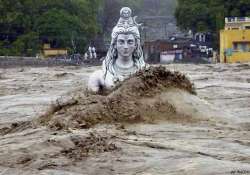New Delhi, Jul 26: Melting of glaciers coupled with monsoon rains, triggering overflow of rivers, were responsible for the Uttarakhand tragedy, a top official of the Ministry of Earth Sciences said here today.
“The flood was not only due to the rains but also because of melting of snow. Rainfall came almost two weeks early in the state. During that period, winter snow was already there. Now when the rain came, snow melted and flowed down along with the rains which increased the volume of water in rivers significantly,” the Ministry secretary Shailesh Nayak said.
Pointing out that his ministry had never declared there was a cloudburst in the state, he said flow of large amount of materials like boulders added to the misery.
Nayak, whose ministry would create a network of state-of-the-art Doppler radars across the entire Himalayan range to improve forecasting, said the local weather report in the state had provided “specific” forecast before the rains, while announcement was also made in Gauri Kund.
Hundreds of people lost their lives in the tragedy that struck the state last month.
Aiming at helping people visiting the hill state, Earth Sciences ministry is planning to to start a mobile service that would post updates about weather conditions, Nayak said.
He said meteorological satellite INSAT-3D, which was launched today, would lead to an “improvement in weather forecast” in the country.
“The understanding of the upper atmosphere will dramatically improve and there will be improvement of weather forecast,” Nayak said.
The Ministry is also spearheading a project to increase the Doppler network in Himalayan states in the next two to three years to improve weather forecasting.
Doppler radars are capable of predicting severe thunderstorms and generating accurate data on wind changes and rain clouds. Three of 15 such radars would be set up in Uttarakhand.
The ministry, which would celebrate the Earth Sciences foundation day tomorrow, would undertake a study on the impact of the polar region on the monsoons in India.
The study will help in getting a proper perspective about the conditions in the next five to 10 years, enabling farmers to plan their harvest accordingly, officials said.
A study would also be undertaken on the evolution of Himalayas and the monsoons as it is linked to the origin of the mountain chain.
Besides, the Ministry is in the process of acquiring an aircraft in about a year's time to study the atmosphere.
Latest India News
